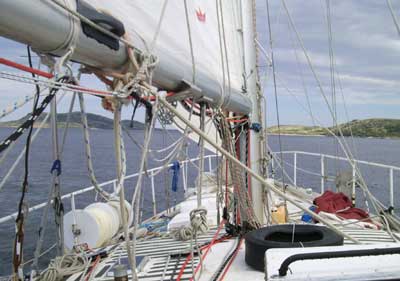 When the sun is shining, the Labrador coast is really beautiful, full of islands, rocks and snow or tree-covered hills. Here we are sailing into a cove to anchor to wait out a coming gale.
When the sun is shining, the Labrador coast is really beautiful, full of islands, rocks and snow or tree-covered hills. Here we are sailing into a cove to anchor to wait out a coming gale.
Monthly Archives: July 2010
Cartwright Ferry
Cartwright, Labrador, Canada
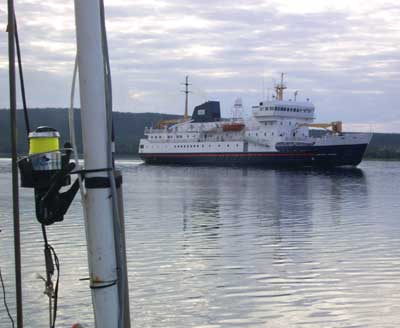 One of the Cartwright ferries. Cartwright used to be at the end of the road (which went to a ferry that went to the island of Newfoundland), and from here, one needed to take a ferry to Goose Bay to get to the rest of Canada. Recently, a new road was opened between Cartwright and Goose Bay. We have been sitting out a gale in Cartwright. A noticeable thing in this pleasant town of 600 is that the phrase “Beautiful Day” is used like “Hello”. The weather doesn’t seem to have any effect on whether or not one should say “hello” or “beautiful day”. Yesterday, in the driving wind and rain of the gale, walking past a person on the muddy road, our conversation went: “Beautiful Day?” “Beautiful Day”
One of the Cartwright ferries. Cartwright used to be at the end of the road (which went to a ferry that went to the island of Newfoundland), and from here, one needed to take a ferry to Goose Bay to get to the rest of Canada. Recently, a new road was opened between Cartwright and Goose Bay. We have been sitting out a gale in Cartwright. A noticeable thing in this pleasant town of 600 is that the phrase “Beautiful Day” is used like “Hello”. The weather doesn’t seem to have any effect on whether or not one should say “hello” or “beautiful day”. Yesterday, in the driving wind and rain of the gale, walking past a person on the muddy road, our conversation went: “Beautiful Day?” “Beautiful Day”
The Repair
Cartwright, Labrador, Canada
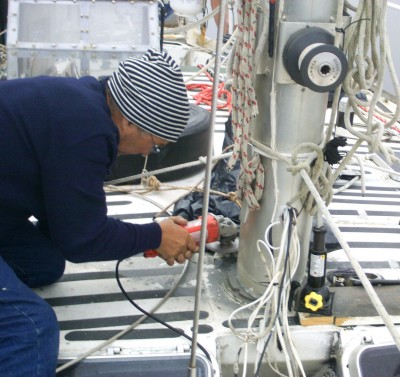 We asked around about lifting equipment in Cartwright. People here are quite helpful, and, being a long way from cities, were used to making do with what is available. There were no cranes in the area, but the town council owned a small excavator. We had a look at the excavator, and it looked capable of lifting the mast, but, before we found the operator, Yann said he could do the repair with just hydraulic jacks. I borrowed a couple of screw jacks from the local service station and we tied the bottom of the mast to several winches to control its movement. Then, as seen in the picture, Yann raised the mast with the jack and cut the bottom 5cm off. The mast was then lowered into its step, and I started work on replacing the broken shrouds and checkstays and tightening/shortening the other wires.
We asked around about lifting equipment in Cartwright. People here are quite helpful, and, being a long way from cities, were used to making do with what is available. There were no cranes in the area, but the town council owned a small excavator. We had a look at the excavator, and it looked capable of lifting the mast, but, before we found the operator, Yann said he could do the repair with just hydraulic jacks. I borrowed a couple of screw jacks from the local service station and we tied the bottom of the mast to several winches to control its movement. Then, as seen in the picture, Yann raised the mast with the jack and cut the bottom 5cm off. The mast was then lowered into its step, and I started work on replacing the broken shrouds and checkstays and tightening/shortening the other wires.
The Damage
Cartwright, Labrador, Canada
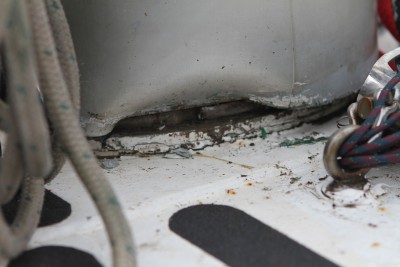 The picture shows the bottom of the mainmast, where the aluminum has been bent when the mast moved out of the mast step. The mast has three pairs of shrouds holding it in place against side-to-side motion, the lowers, the intermediates and the uppers. The lower shroud, made of wire, broke. The intermediate and upper shrouds, were made of a synthetic rope rigging material called Dynex Dux that I’d installed in Argentina and Uruguay. Almost immediately after the lower shroud broke (we only heard one bang), the mast bent under the pressure of the sails and the checkstay, which was made of another synthetic rope called Spectra, bent the bolt it attached to the mast with and broke. The pressure of the sails also came on the intermediate and upper shrouds, however, they stretched, and did not break. The stretching of the intermediate and upper shrouds, meant that the lower shroud, which was wire, and, to a lesser extent, the Spectra checkstay, took more of the load of the sails and broke. The mast is stepped on deck. I had not unstepped the masts before, so did not know that the mast step is only a 1cm high aluminum plate that fits the bottom of the mast tightly. That small a surface for the step works fine, as long as the mast is held tightly in place by the shrouds and stays. The shroud breaking and the other shrouds stretching allowed the mast to move more than the step could handle, so the mast moved out of the step and got bent while moving.
The picture shows the bottom of the mainmast, where the aluminum has been bent when the mast moved out of the mast step. The mast has three pairs of shrouds holding it in place against side-to-side motion, the lowers, the intermediates and the uppers. The lower shroud, made of wire, broke. The intermediate and upper shrouds, were made of a synthetic rope rigging material called Dynex Dux that I’d installed in Argentina and Uruguay. Almost immediately after the lower shroud broke (we only heard one bang), the mast bent under the pressure of the sails and the checkstay, which was made of another synthetic rope called Spectra, bent the bolt it attached to the mast with and broke. The pressure of the sails also came on the intermediate and upper shrouds, however, they stretched, and did not break. The stretching of the intermediate and upper shrouds, meant that the lower shroud, which was wire, and, to a lesser extent, the Spectra checkstay, took more of the load of the sails and broke. The mast is stepped on deck. I had not unstepped the masts before, so did not know that the mast step is only a 1cm high aluminum plate that fits the bottom of the mast tightly. That small a surface for the step works fine, as long as the mast is held tightly in place by the shrouds and stays. The shroud breaking and the other shrouds stretching allowed the mast to move more than the step could handle, so the mast moved out of the step and got bent while moving.
BANG!
Labrador Sea, Canada
On a pleasant day in the Labrador Sea, we were sailing along in a fresh, following breeze, about 40 miles offshore. The sudden noise sounded like a gunshot. It took a few seconds to realize that two of the wires/ropes holding the mainmast up had snapped. The mainmast was wobbling, and very close to crashing down. We got the mainsail and the main staysail down. Yann climbed the mast and tied the remains of the checkstay in place around the lower spreaders and we tightened it with a winch to stop the mast from wiggling. With a SE wind, we were able to change course and sail northwest along the coast using sails on the foremast alone. We set course for Cartwright, a major town of 600 people, about 65 miles away. As night fell, we sailed more slowly, for much of the night under storm jib alone, just poking along at 2.5 knots–a slow enough speed that if we ran into any ice in the darkness and fog, it would not damage the boat. The fog lifted with the dawn, the wind died, and we motored into Cartwright harbor and tied up at the dock.
Foredeck
Labrador Sea, Canada
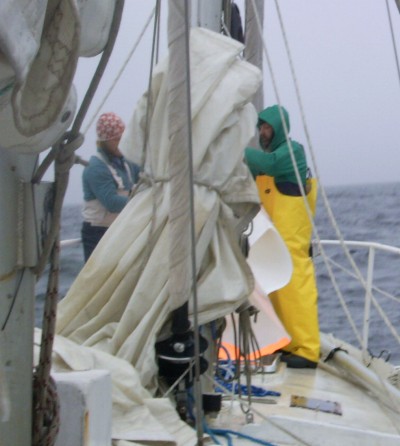 Ted (left) and Chris attaching the storm jib on the foredeck as we motor out of the harbor and get ready to set sail.
Ted (left) and Chris attaching the storm jib on the foredeck as we motor out of the harbor and get ready to set sail.
Wetsuit Test
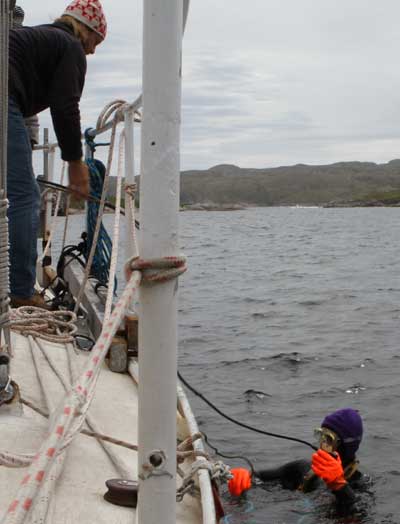 While approaching an anchorage in Labrador, a rope went over the side and got caught underneath the boat. The next morning, I dug up my wetsuit and went in to free the rope and scrub the keel–a job I’d been wanting to do for a while but hadn’t gotten around to yet. In the picture, Ted has just passed me down the regulator, and I’m putting it on. The boat has a diving compressor (narghile), which pumps air down a hose to the regulator. This is the first time I tried using the system, and it takes a while to get used to breathing thru the regulator. A heated swimming pool would be an easier place to learn to breathe thru a regulator than a Labrador harbor with icebergs outside, but nothing is perfect :). I used several big shackles as diving weights and was in the water about half an hour (the wetsuit is thicker than most), getting one side of the keel scrubbed. The other side of the keel will wait until next time.
While approaching an anchorage in Labrador, a rope went over the side and got caught underneath the boat. The next morning, I dug up my wetsuit and went in to free the rope and scrub the keel–a job I’d been wanting to do for a while but hadn’t gotten around to yet. In the picture, Ted has just passed me down the regulator, and I’m putting it on. The boat has a diving compressor (narghile), which pumps air down a hose to the regulator. This is the first time I tried using the system, and it takes a while to get used to breathing thru the regulator. A heated swimming pool would be an easier place to learn to breathe thru a regulator than a Labrador harbor with icebergs outside, but nothing is perfect :). I used several big shackles as diving weights and was in the water about half an hour (the wetsuit is thicker than most), getting one side of the keel scrubbed. The other side of the keel will wait until next time.
Icebergs
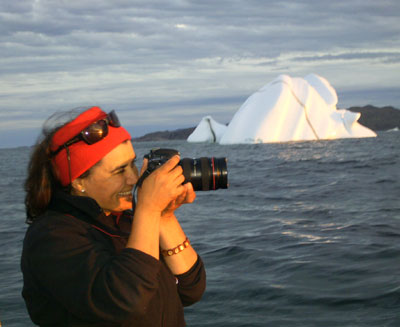 We sailed by a lot of icebergs, whales and dolphins along the coast of Labrador.
We sailed by a lot of icebergs, whales and dolphins along the coast of Labrador.
Abandoned
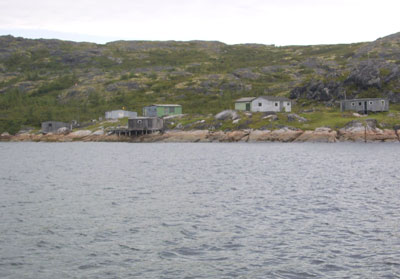 Abandoned buildings at Hill Harbor, Labrador. This is a very small harbor nestled in the rocky coast–easy to enter with GPS and clear, calm weather. I don’t know the history of this particular place at all, and haven’t gone ashore yet. I suspect it was one of the many places that were abandoned after seal hunting (for fur) was ended and the numbers of cod fish collapsed. No road, transportation only by boat or across the ice when it freezes over.
Abandoned buildings at Hill Harbor, Labrador. This is a very small harbor nestled in the rocky coast–easy to enter with GPS and clear, calm weather. I don’t know the history of this particular place at all, and haven’t gone ashore yet. I suspect it was one of the many places that were abandoned after seal hunting (for fur) was ended and the numbers of cod fish collapsed. No road, transportation only by boat or across the ice when it freezes over.
Yann Back Onboard
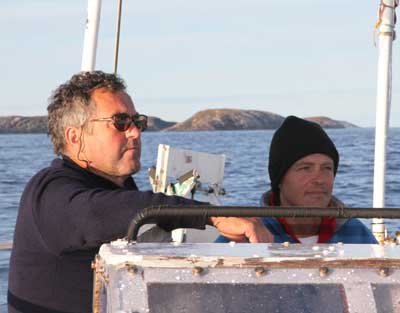 Yann, who built Issuma in France and sailed her 48,000 miles before selling her to me, joined the the boat in St John’s for the summer. Picture was taken along the Labrador coast.
Yann, who built Issuma in France and sailed her 48,000 miles before selling her to me, joined the the boat in St John’s for the summer. Picture was taken along the Labrador coast.